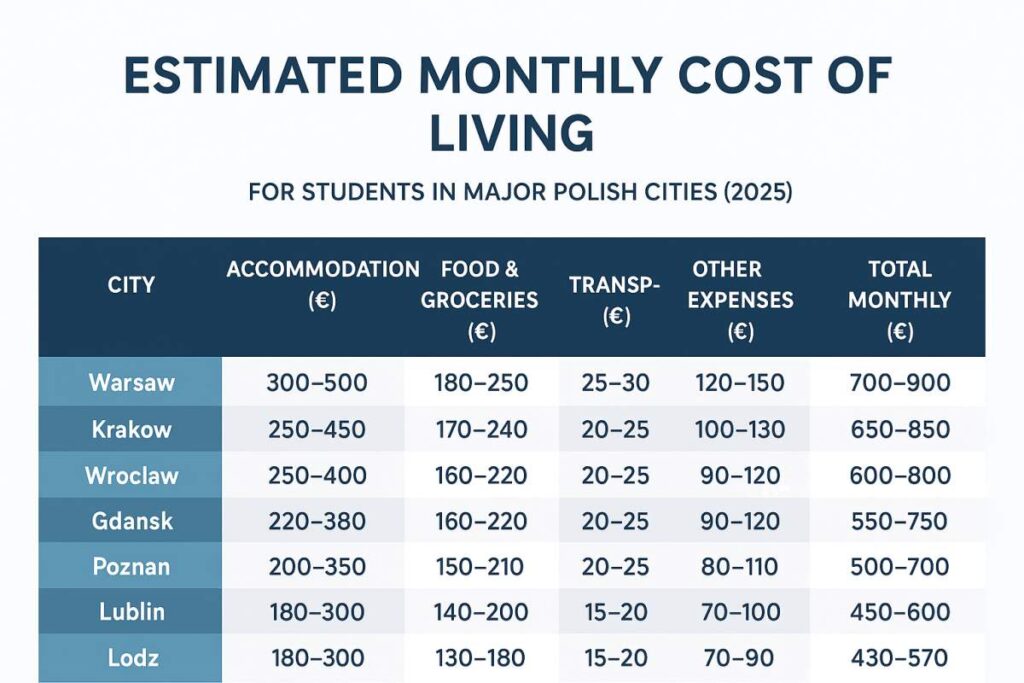
Introduction
If you are planning to study in Poland, understanding the cost of living is just as important as learning about the student visa requirements. While the Poland student visa requires proof of financial stability, knowing the actual expenses you’ll face helps you plan your budget realistically. This guide explains the monthly living costs for international students in Poland, covering accommodation, food, transportation, healthcare, and miscellaneous expenses. It also compares living costs across major Polish cities such as Warsaw, Krakow, Wroclaw, Gdansk, and others. Whether you’re applying for a Poland student visa or exploring how much bank balance you need, this detailed article will help you prepare financially before moving to Poland.
Average Monthly Cost of Living in Poland for Students
On average, international students in Poland spend between €500 and €900 per month, depending on the city and lifestyle. Warsaw, Krakow, and Wroclaw tend to be slightly more expensive than smaller cities like Lublin, Lodz, and Bialystok, which are more affordable. Below is a detailed table of estimated monthly costs for 2025.
Estimated Monthly Cost of Living for Students in Major Polish Cities
| City | Accommodation (€) | Food & Groceries (€) | Transport (€) | Other Expenses (€) | Total Monthly (€) |
|---|---|---|---|---|---|
| Warsaw | 300–500 | 180–250 | 25–30 | 120–150 | 700–900 |
| Krakow | 250–450 | 170–240 | 20–25 | 100–130 | 650–850 |
| Wroclaw | 250–400 | 160–220 | 20–25 | 90–120 | 600–800 |
| Gdansk | 220–380 | 160–220 | 20–25 | 90–120 | 550–750 |
| Poznan | 200–350 | 150–210 | 20–25 | 80–110 | 500–700 |
| Lublin | 180–300 | 140–200 | 15–20 | 70–100 | 450–600 |
| Lodz | 180–300 | 140–190 | 15–20 | 70–100 | 450–600 |
| Bialystok | 170–280 | 130–180 | 15–20 | 70–90 | 430–570 |
Breakdown of Major Expenses
1. Accommodation Costs
Accommodation is the biggest monthly expense for students in Poland. The cost depends on whether you live in a university dormitory or rent a private apartment. Dormitory rooms cost around €100–200 per month, while private apartments can range between €250–500 depending on location and facilities. Sharing an apartment with other students reduces the costs significantly, with average shared accommodation costing €150–300 per student. Universities in Poland offer affordable dormitories, making them a great option for international students trying to save money.
2. Food & Groceries
Food and grocery expenses typically range from €150–250 per month in Poland. Polish supermarkets like Biedronka, Lidl, Carrefour, and Auchan are popular for affordable prices. Students who prefer cooking at home can save considerable money. Eating out at student-friendly restaurants costs about €5–8 per meal, and occasional dining at cafes or international chains will not exceed €10–12. Poland’s food is both tasty and budget-friendly, with plenty of vegetarian and halal options also available.
3. Transportation Costs
Public transport in Poland is efficient, safe, and affordable. Students benefit from discounted travel passes that reduce monthly commuting expenses. A monthly public transport pass costs between €15–30, while a single bus or tram ticket is €0.80–1.20. Bicycles and electric scooters are also common in major student cities like Warsaw, Krakow, and Wroclaw. Various universities are located near student housing, allowing easy walking distance to campus, saving even more on transportation.
4. Healthcare & Insurance
Health insurance is an essential requirement for all international students in Poland. It ensures medical support during your stay. Private health insurance costs around €30–50 per month, while the public option through NFZ (National Health Fund) costs €10–15 per month. Students applying for a Poland student visa must show valid health insurance coverage as part of their visa documentation. Having reliable health insurance not only protects your health but also strengthens your visa application.
5. Other Personal Expenses
Other expenses include phone bills, internet, entertainment, gym memberships, and personal care. Internet and mobile packages cost around €15–25 per month. A gym membership costs €20–30, while leisure and entertainment, such as movies or social outings, can total €40–70 monthly. These costs depend heavily on lifestyle, but Poland remains much more affordable than Western Europe in all categories.
Cost of Living in Poland vs. Other European Countries
Poland offers one of the lowest costs of living in the European Union. Compared to other Western European countries, the difference is substantial. For example, Germany or the Netherlands may require €900–1200 per month for living expenses, and France averages €1000–1500 per month. In contrast, students in Poland comfortably live on €500–900. This affordability, combined with world-class education and a safe environment, makes Poland a top destination for international students seeking quality education without financial burden.
Money-Saving Tips for Students in Poland
- Choose university dormitories instead of private apartments to reduce rent costs.
- Use student ID cards for discounts on transportation, restaurants, and entertainment.
- Cook meals at home and shop at affordable supermarkets like Lidl or Biedronka.
- Take advantage of international student cards (ISIC, ESN) for travel and lifestyle discounts.
- Opt for budget-friendly cities like Lublin or Lodz instead of Warsaw for lower rent and food costs.
Conclusion
The cost of living in Poland for international students in 2025 remains among the lowest in Europe, typically between €500–900 per month, depending on the city and lifestyle. Warsaw and Krakow are vibrant yet slightly more expensive, while cities like Lublin, Lodz, and Bialystok offer excellent affordability. By managing your accommodation, food, and transport wisely, you can maintain a comfortable life while studying abroad. Understanding these expenses also helps when preparing your Poland student visa application and demonstrating financial capability.

